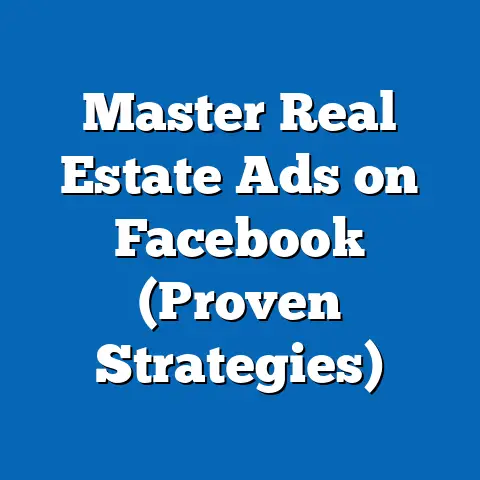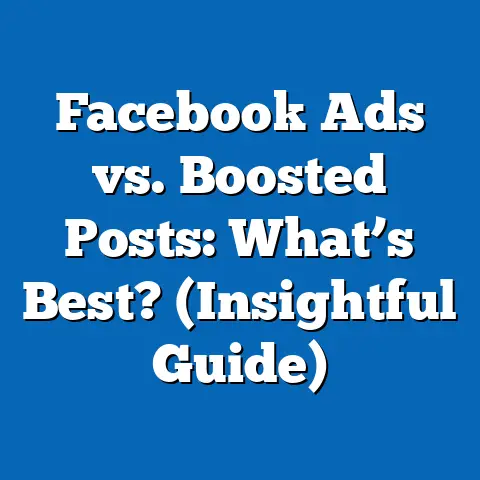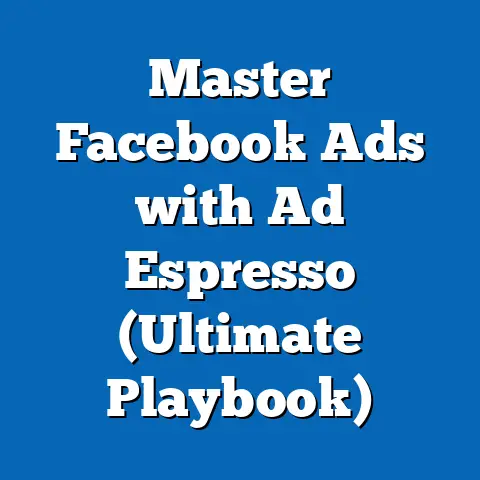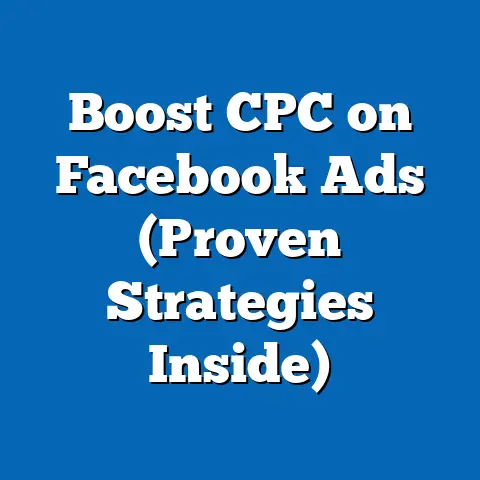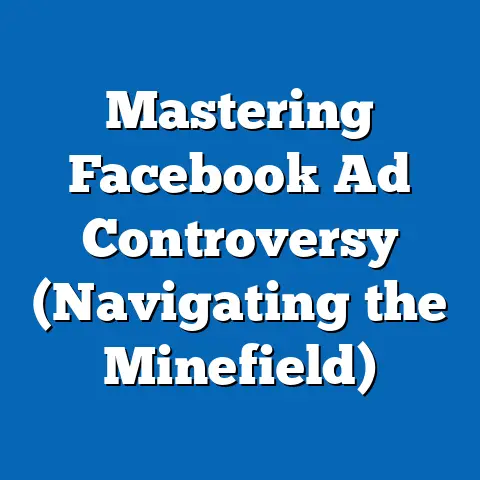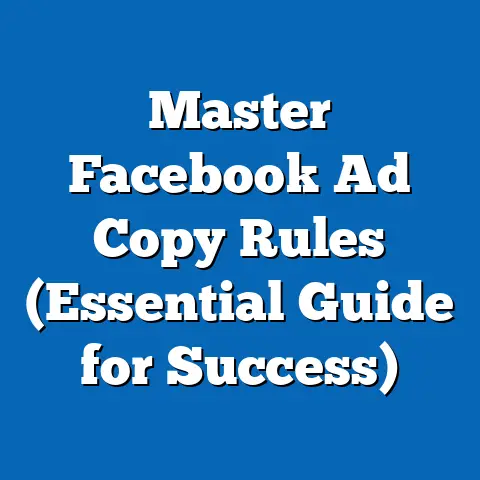Unlocking Facebook’s Collection Ads (Boost Engagement Strategy)
Social media ad spending is on a relentless climb. Statista projects that social media advertising spending will reach over $260 billion globally by 2024. This tells me that brands recognize the power of reaching their target audience in a space where they’re already engaged. The key is to create ads that don’t feel like interruptions, but rather, enhance the user experience.
Section 1: Understanding Facebook’s Collection Ads
Before diving into the “how,” let’s establish a solid understanding of the “what.” What exactly are Facebook’s Collection Ads, and why are they such a game-changer?
What are Collection Ads?
Collection Ads are a unique ad format on Facebook designed to showcase multiple products in a visually engaging way. Think of them as a mini-catalog right within the Facebook newsfeed. Unlike a single image or video ad, Collection Ads allow users to browse a curated selection of products directly from the ad itself.
I like to think of them as the digital equivalent of browsing a beautifully arranged store window. They capture your attention, pique your curiosity, and invite you to step inside and explore.
But what truly sets Collection Ads apart from other formats like Carousel or Single Image Ads?
-
Carousel Ads: These allow you to showcase multiple images or videos, each with its own link. While effective, they can feel somewhat disjointed.
-
Single Image Ads: These are simple and direct but lack the depth to showcase a range of products.
-
Collection Ads: These offer a more immersive and streamlined experience. They start with a compelling cover image or video, followed by a selection of relevant products displayed below. This format creates a cohesive and visually appealing journey for the user, making it easier for them to discover and purchase items.
Carousel Ads: These allow you to showcase multiple images or videos, each with its own link. While effective, they can feel somewhat disjointed.
Single Image Ads: These are simple and direct but lack the depth to showcase a range of products.
Collection Ads: These offer a more immersive and streamlined experience. They start with a compelling cover image or video, followed by a selection of relevant products displayed below. This format creates a cohesive and visually appealing journey for the user, making it easier for them to discover and purchase items.
Anatomy of a Collection Ad
Let’s break down the key components of a Collection Ad:
- Cover Image/Video: This is the first thing users see, and it needs to be attention-grabbing. It should be high-quality, visually appealing, and relevant to the products being featured.
- Product Set: This is the selection of products displayed below the cover image/video. These products should be carefully curated to appeal to the target audience and align with the overall theme of the ad.
- Instant Experience (Previously Canvas): Clicking on the Collection Ad typically opens an Instant Experience, a full-screen, mobile-optimized landing page. This provides a richer, more immersive browsing experience, allowing users to explore products in greater detail.
- Product Pages: From the Instant Experience, users can easily navigate to individual product pages on your website to learn more and make a purchase.
The beauty of this structure is its seamlessness. Users can go from initial discovery to product details with just a few taps, creating a frictionless path to purchase.
Who Should Use Collection Ads?
Collection Ads aren’t a one-size-fits-all solution. They’re particularly well-suited for certain industries and businesses:
- E-commerce Businesses: This is the obvious one. Any online store selling multiple products can benefit from showcasing their offerings in a visually appealing way.
- Fashion Retailers: The visual nature of Collection Ads makes them perfect for showcasing clothing, accessories, and style inspiration.
- Home Goods Stores: Displaying curated collections of furniture, décor, and appliances can inspire customers to create their dream homes.
- Beauty Brands: Showcasing makeup looks, skincare routines, and product bundles can drive sales and build brand awareness.
But don’t let this list limit you. I’ve seen Collection Ads work wonders for businesses in unexpected niches. The key is to think creatively about how you can present your products in a visually compelling way that resonates with your target audience.
For example, I once worked with a local artisanal coffee roaster. They used Collection Ads to showcase different coffee bean varieties, brewing methods, and even complementary accessories like mugs and grinders. The result was a significant increase in online sales and a stronger brand identity.
How Collection Ads Work: The Mechanics
At their core, Collection Ads are designed to enhance the user experience by:
- Visually Appealing Presentation: The combination of a captivating cover image/video and a curated product selection immediately grabs attention.
- Seamless Navigation: The Instant Experience provides a smooth and intuitive browsing experience, making it easy for users to explore products in detail.
- Mobile Optimization: Collection Ads are designed specifically for mobile devices, ensuring a seamless experience for the majority of Facebook users.
- Targeted Reach: Facebook’s powerful targeting options allow you to reach the right audience with the right products, maximizing engagement and conversions.
Takeaway: Collection Ads are a powerful format for e-commerce businesses looking to showcase multiple products in a visually engaging way. Understanding their anatomy, target audience, and mechanics is crucial for creating effective campaigns. Next, I’ll guide you through the step-by-step process of setting up your first Collection Ad.
Section 2: Setting Up Your Collection Ads
Now that you understand the power of Collection Ads, let’s get practical. I’m going to walk you through the step-by-step process of creating your first Collection Ad, from choosing the right products to setting up your campaign in Facebook Ads Manager.
Step-by-Step Guide to Creating a Collection Ad
- Access Facebook Ads Manager: Log in to your Facebook Business Manager account and navigate to Ads Manager.
- Create a New Campaign: Click the “+ Create” button to start a new campaign.
- Choose Your Objective: Select an objective that aligns with your goals. Common objectives for Collection Ads include “Sales,” “Traffic,” or “Brand Awareness.”
- Campaign Budget Optimization (CBO): Decide whether to use CBO to optimize your budget across ad sets. This can be a good option if you’re testing multiple audiences.
-
Ad Set Level:
- Define Your Audience: This is where Facebook’s targeting capabilities shine. You can target based on demographics, interests, behaviors, and more. I highly recommend creating custom audiences based on your website visitors, email lists, or previous purchasers.
- Placements: Choose where you want your ads to appear. Facebook, Instagram, Audience Network, and Messenger are all options. For Collection Ads, I typically recommend focusing on Facebook and Instagram feeds.
- Budget and Schedule: Set your daily or lifetime budget and choose your start and end dates.
-
Ad Level:
- Choose the “Collection” Format: Select “Collection” as your ad format.
- Select Your Product Catalog: Connect your product catalog to the ad. This catalog should be properly formatted and up-to-date.
- Choose Your Cover Image/Video: Select a high-quality image or video that will capture attention. Make sure it’s relevant to the products you’re featuring.
- Write Compelling Ad Copy: Craft clear and concise ad copy that highlights the benefits of your products and encourages users to click.
- Select Your Instant Experience Template: Choose a pre-designed template or create your own custom Instant Experience.
- Select Products for Your Instant Experience: Choose the products you want to feature in your Instant Experience.
- Add a Call-to-Action Button: Include a clear call-to-action button, such as “Shop Now,” “Learn More,” or “Browse Products.”
- Track Conversions: Ensure you have Facebook Pixel installed on your website to track conversions and measure the success of your ad.
- Review and Publish: Review your ad to make sure everything is correct, and then click “Publish.”
Ad Set Level:
- Define Your Audience: This is where Facebook’s targeting capabilities shine. You can target based on demographics, interests, behaviors, and more. I highly recommend creating custom audiences based on your website visitors, email lists, or previous purchasers.
- Placements: Choose where you want your ads to appear. Facebook, Instagram, Audience Network, and Messenger are all options. For Collection Ads, I typically recommend focusing on Facebook and Instagram feeds.
- Budget and Schedule: Set your daily or lifetime budget and choose your start and end dates.
Ad Level:
- Choose the “Collection” Format: Select “Collection” as your ad format.
- Select Your Product Catalog: Connect your product catalog to the ad. This catalog should be properly formatted and up-to-date.
- Choose Your Cover Image/Video: Select a high-quality image or video that will capture attention. Make sure it’s relevant to the products you’re featuring.
- Write Compelling Ad Copy: Craft clear and concise ad copy that highlights the benefits of your products and encourages users to click.
- Select Your Instant Experience Template: Choose a pre-designed template or create your own custom Instant Experience.
- Select Products for Your Instant Experience: Choose the products you want to feature in your Instant Experience.
- Add a Call-to-Action Button: Include a clear call-to-action button, such as “Shop Now,” “Learn More,” or “Browse Products.”
- Track Conversions: Ensure you have Facebook Pixel installed on your website to track conversions and measure the success of your ad.
The Importance of a Well-Optimized Product Catalog
Your product catalog is the backbone of your Collection Ad. A well-optimized catalog ensures that your products are displayed accurately and effectively. Here are some key considerations:
- Accurate Product Information: Ensure that all product details, such as titles, descriptions, prices, and availability, are accurate and up-to-date.
- High-Quality Images: Use high-resolution images that showcase your products in the best possible light.
- Product Categorization: Properly categorize your products to make it easier for users to find what they’re looking for.
- Product Identifiers: Use unique product identifiers, such as SKUs or GTINs, to ensure that your products are correctly matched to your website.
I once worked with a clothing retailer whose Collection Ads were underperforming. After auditing their product catalog, I discovered that many of their product images were low-resolution and their product descriptions were poorly written. By updating their catalog with high-quality images and compelling descriptions, we saw a significant improvement in their ad performance.
Creative Assets: Capturing Attention
Your creative assets – the cover image/video and ad copy – are what will initially grab the attention of your target audience. Here are some best practices:
- High-Quality Visuals: Use professional-quality images or videos that are visually appealing and relevant to your products.
- Compelling Storytelling: Use your visuals to tell a story that resonates with your target audience.
- Clear and Concise Ad Copy: Write ad copy that is easy to understand and highlights the benefits of your products.
- Strong Call-to-Action: Use a clear and concise call-to-action that encourages users to click.
Ad Placements and Targeting Options
Choosing the right ad placements and targeting options is crucial for maximizing reach and engagement. Here are some tips:
- Facebook and Instagram Feeds: These are typically the most effective placements for Collection Ads.
- Targeting Options: Use Facebook’s targeting options to reach the right audience with the right products. Consider targeting based on demographics, interests, behaviors, and custom audiences.
- A/B Testing: Test different ad placements and targeting options to see what works best for your business.
Takeaway: Setting up Collection Ads involves a multi-step process, from choosing the right products to crafting compelling creative assets. A well-optimized product catalog and strategic targeting options are crucial for maximizing reach and engagement. Next, I’ll explore how Collection Ads can significantly boost user engagement compared to traditional ad formats.
Section 3: Boosting Engagement with Collection Ads
Now, let’s delve into the core of the matter: how Collection Ads can significantly boost user engagement compared to traditional ad formats. This is where the true power of this ad type lies.
Why Collection Ads Drive Higher Engagement
Collection Ads are designed to be more engaging than traditional ad formats for several key reasons:
- Visual Appeal: The combination of a captivating cover image/video and a curated product selection immediately grabs attention and piques curiosity.
- Immersive Experience: The Instant Experience provides a richer, more interactive browsing experience than simply clicking through to a product page.
- Seamless Navigation: Users can easily browse multiple products and navigate to individual product pages with just a few taps.
- Mobile Optimization: Collection Ads are designed specifically for mobile devices, ensuring a seamless experience for the majority of Facebook users.
In essence, Collection Ads offer a more engaging and user-friendly experience that encourages users to explore your products and ultimately make a purchase.
Emotional and Psychological Triggers
Collection Ads tap into several emotional and psychological triggers that can drive higher engagement:
- Curiosity: The cover image/video is designed to pique curiosity and encourage users to click.
- Fear of Missing Out (FOMO): Showcasing a curated selection of products can create a sense of urgency and encourage users to explore the collection before it’s gone.
- Inspiration: Collection Ads can inspire users to discover new products and trends that they might not have otherwise considered.
- Convenience: The seamless navigation and mobile optimization make it easy for users to browse and purchase products on the go.
I’ve found that understanding these triggers and incorporating them into your ad creative can significantly boost engagement. For example, using a cover image that features a limited-edition product or a trending style can create a sense of urgency and encourage users to click.
Case Studies: Real-World Success with Collection Ads
Let’s take a look at some real-world examples of brands that have successfully used Collection Ads to increase engagement:
- Fashion Retailer: A major fashion retailer used Collection Ads to showcase their new fall collection. They saw a 30% increase in click-through rates and a 20% increase in online sales compared to their previous ad campaigns.
- Home Goods Store: A home goods store used Collection Ads to showcase their curated collection of living room furniture. They saw a 25% increase in engagement rate and a 15% increase in average order value.
- Beauty Brand: A beauty brand used Collection Ads to showcase their new line of skincare products. They saw a 40% increase in website traffic and a 25% increase in lead generation.
These case studies demonstrate the potential of Collection Ads to drive significant results for businesses across various industries.
Creating an Immersive Shopping Experience
Collection Ads facilitate a more immersive shopping experience by:
- Providing a Visual Feast: The combination of high-quality images and videos creates a visually appealing and engaging experience.
- Offering a Curated Selection: Showcasing a curated selection of products makes it easier for users to discover items that they’re interested in.
- Creating a Seamless Journey: The Instant Experience provides a smooth and intuitive browsing experience, making it easy for users to explore products in detail and make a purchase.
This immersive experience can lead to higher conversion rates because users are more engaged and informed when they reach your website.
Takeaway: Collection Ads drive higher engagement by being visually appealing, tapping into emotional triggers, and creating an immersive shopping experience. Real-world case studies demonstrate their potential to deliver significant results for businesses across various industries. Next, I’ll delve into how to measure the success of your Collection Ads and optimize them for maximum performance.
Section 4: Measuring Success and Optimizing Collection Ads
You’ve launched your Collection Ads – congratulations! But the work doesn’t stop there. It’s crucial to track your results, analyze your data, and optimize your campaigns for maximum performance. This section will guide you through the key performance indicators (KPIs) you should be tracking and the strategies you can use to fine-tune your ads for optimal success.
Key Performance Indicators (KPIs) for Collection Ads
When running Collection Ads, there are several key performance indicators (KPIs) that you should be tracking:
- Impressions: The number of times your ad was displayed.
- Reach: The number of unique people who saw your ad.
- Click-Through Rate (CTR): The percentage of people who saw your ad and clicked on it. This is a key indicator of how engaging your ad is.
- Engagement Rate: The percentage of people who interacted with your ad (e.g., likes, comments, shares).
- Cost Per Click (CPC): The average cost you pay each time someone clicks on your ad.
- Conversion Rate: The percentage of people who clicked on your ad and completed a desired action (e.g., made a purchase, filled out a form).
- Return on Ad Spend (ROAS): The amount of revenue you generate for every dollar you spend on advertising. This is the ultimate measure of your ad’s profitability.
I recommend setting up a custom dashboard in Facebook Ads Manager to track these KPIs in real-time. This will allow you to quickly identify trends and make adjustments to your campaigns as needed.
A/B Testing for Optimization
A/B testing is a powerful technique for optimizing your Collection Ads. It involves creating two versions of your ad with slight variations and then comparing their performance to see which one performs better.
Here are some elements of your Collection Ads that you can A/B test:
- Cover Image/Video: Try different visuals to see which ones capture the most attention.
- Ad Copy: Test different headlines, descriptions, and calls-to-action to see which ones resonate best with your target audience.
- Product Selection: Experiment with different product combinations to see which ones drive the most sales.
- Targeting Options: Test different targeting options to see which ones reach the most engaged audience.
- Instant Experience Template: Try different templates to see which ones provide the best user experience.
When A/B testing, it’s important to only change one element at a time so that you can accurately attribute the results to that specific change.
For example, I once worked with a furniture retailer who was struggling to improve the CTR of their Collection Ads. We decided to A/B test two different cover images: one featuring a lifestyle shot of a living room and the other featuring a close-up shot of a sofa. The lifestyle shot significantly outperformed the close-up shot, resulting in a 20% increase in CTR.
Leveraging Facebook Analytics
Facebook Analytics provides valuable insights into how users are interacting with your Collection Ads and your website. You can use Facebook Analytics to:
- Track Website Traffic: See how many people are visiting your website from your Collection Ads.
- Analyze User Behavior: Understand how users are navigating your website and which products they’re viewing.
- Identify Conversion Funnels: Track the steps that users take before making a purchase and identify any bottlenecks in the process.
- Create Custom Audiences: Build custom audiences based on user behavior on your website.
By analyzing this data, you can gain a deeper understanding of your target audience and optimize your Collection Ads to better meet their needs.
Making Data-Driven Adjustments
Based on your data analysis, you can make a variety of adjustments to your Collection Ads to enhance results:
- Refine Your Targeting: If you’re not reaching the right audience, adjust your targeting options to be more specific.
- Improve Your Ad Copy: If your ad copy isn’t resonating with your target audience, rewrite it to be more compelling and relevant.
- Optimize Your Cover Image/Video: If your cover image/video isn’t capturing attention, try a different visual.
- Adjust Your Product Selection: If certain products aren’t performing well, replace them with more popular items.
- Optimize Your Instant Experience: If your Instant Experience is clunky or difficult to navigate, simplify it and make it more user-friendly.
Takeaway: Measuring the success of your Collection Ads and optimizing them based on data analysis is crucial for maximizing performance. By tracking key KPIs, A/B testing different elements, and leveraging Facebook Analytics, you can fine-tune your campaigns to achieve optimal results. Next, I’ll gaze into the crystal ball and explore the future of Collection Ads.
Section 5: The Future of Collection Ads
The world of social media advertising is constantly evolving, and Facebook is no exception. So, what does the future hold for Collection Ads? Let’s speculate on upcoming trends, potential updates, and the integration of emerging technologies.
Upcoming Trends and Potential Updates
Facebook is always experimenting with new features and formats, so it’s likely that we’ll see some exciting updates to Collection Ads in the near future. Here are a few possibilities:
- More Interactive Elements: We might see the introduction of interactive elements within the Instant Experience, such as quizzes, polls, or augmented reality (AR) experiences.
- Enhanced Personalization: Facebook could leverage its vast data trove to personalize Collection Ads even further, showing users products that are highly relevant to their interests and preferences.
- Improved Measurement Tools: We might see the introduction of more sophisticated measurement tools that provide deeper insights into ad performance.
- Integration with Other Platforms: Facebook could integrate Collection Ads with other platforms, such as WhatsApp or Messenger, to create a more seamless shopping experience.
It’s important to stay up-to-date on these changes and adapt your strategies accordingly. I make it a habit to regularly check Facebook’s official resources and industry blogs to stay informed about the latest updates.
The Role of AR/VR
Augmented reality (AR) and virtual reality (VR) have the potential to revolutionize the way we shop online. Imagine being able to virtually “try on” clothes or “place” furniture in your home before making a purchase.
While AR/VR technology is still in its early stages, I believe that it will eventually be integrated into Collection Ads. This could involve allowing users to:
- Virtually Try On Products: Use their smartphone camera to see how clothes or makeup would look on them.
- Visualize Products in Their Home: Place virtual furniture or décor items in their home using AR technology.
- Explore Virtual Showrooms: Immerse themselves in virtual showrooms that showcase a wide range of products.
This would create an even more engaging and immersive shopping experience, leading to higher conversion rates and increased customer satisfaction.
AI-Driven Personalization
Artificial intelligence (AI) is already playing a major role in digital marketing, and its impact on Collection Ads is likely to grow in the future. AI can be used to:
- Personalize Product Recommendations: Show users products that are highly relevant to their interests and preferences.
- Optimize Ad Creative: Automatically generate ad copy and visuals that are tailored to specific audiences.
- Predict User Behavior: Anticipate what products users are likely to be interested in and show them relevant ads at the right time.
By leveraging AI-driven personalization, businesses can create more effective Collection Ads that drive higher engagement and conversions.
Staying Ahead of the Curve
The key to success in the ever-changing world of digital marketing is to stay ahead of the curve. This means:
- Staying Informed: Regularly checking Facebook’s official resources and industry blogs to stay up-to-date on the latest trends and updates.
- Experimenting with New Features: Trying out new features and formats as soon as they’re released.
- Analyzing Your Results: Tracking your results and making adjustments to your strategies as needed.
- Embracing Innovation: Being open to new ideas and technologies.
Takeaway: The future of Collection Ads is bright. Upcoming trends, potential updates, and the integration of AR/VR and AI-driven personalization will create even more engaging and effective shopping experiences. By staying ahead of the curve, you can leverage these advancements to drive significant results for your business.
I hope I’ve made it clear that Collection Ads are more than just another ad format. They represent a powerful tool for engaging your target audience, creating immersive shopping experiences, and driving significant results for your business.
The connection between engaging ad formats and successful e-commerce strategies is undeniable. In today’s competitive landscape, businesses need to find creative ways to stand out from the crowd and capture the attention of their target audience. Collection Ads offer a unique opportunity to do just that.
I encourage you to consider how you can implement Collection Ads into your marketing efforts. Experiment with different creative assets, targeting options, and product selections to see what works best for your business. Don’t be afraid to try new things and push the boundaries of what’s possible.
The landscape of social media advertising is constantly evolving, and the necessity for brands to adapt to stay competitive has never been more critical. By embracing new ad formats like Collection Ads and staying ahead of the curve, you can position your business for long-term success in the digital age.
So, go forth and unlock the power of Facebook’s Collection Ads. I’m confident that you’ll be amazed at the results you can achieve. Good luck, and happy advertising!

